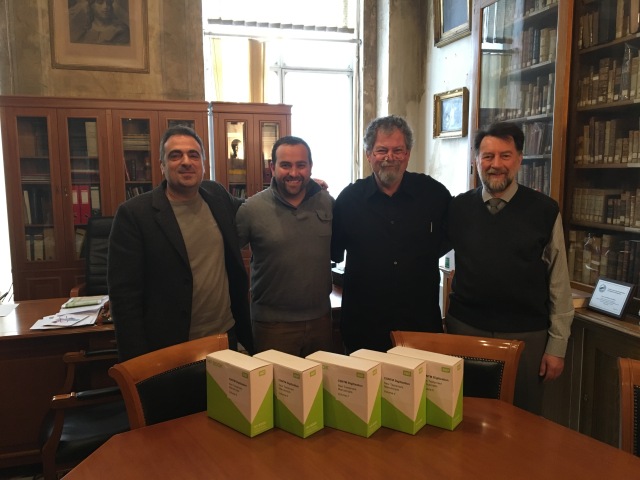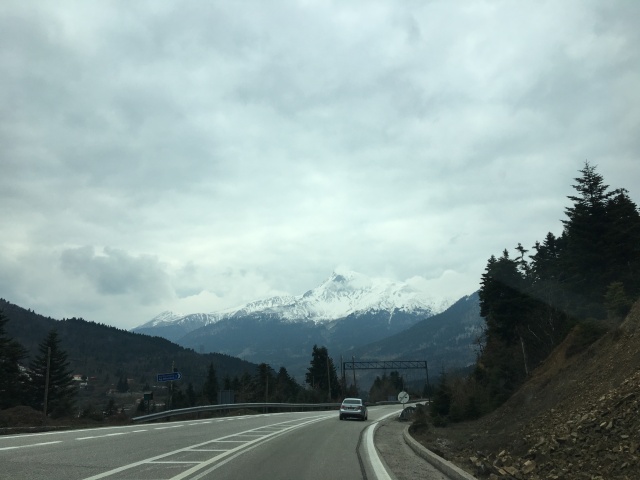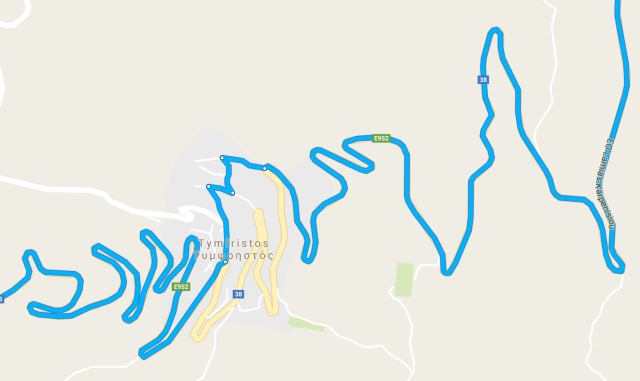Update on the work of the
Center for the Study of New Testament Manuscripts (CSNTM):
On March 13, 2017, Rob Marcello and I made a ‘front trip’ to central Greece. A front trip is one prior to digitizing manuscripts. As always, whenever we meet face to face with people, things happen. These front trips are absolutely essential for the ongoing work of the Center. It is still a true adage: it’s not just what you know but who you know that counts.
Briefly, we visited two monasteries in central Greece. The bishop of the region was truly accommodating and wants us to bring technology to these monasteries. His concern, and very legitimate at that, is to digitize these artifacts before they turn to dust.
Rob did a remarkable job of driving on the treacherously narrow mountain roads—sometimes in sleet and snow—and often with no guardrails protecting us from a sheer drop-off. At one point, a little Miata zipped around a corner and almost drove into us (his half of the road was down the middle). We swerved and so did he. But our swerve was on the outside. This kind of thing happens a bit too often in the mountains of Greece. That’s why there’s a cross atop a small shrine dotting the roadside every couple hundred yards: it marks the place where someone expired unceremoniously and unexpectedly.

Rocky overhang on the way to our first monastery
On the morning of the ides of March, we met with the director of the National Library of Greece. CSNTM spent the last two years digitizing all of the Greek NT MSS at the NLG. 45 people went to Athens to do this work with state-of-the-art equipment, in teams of 7–8 people at a time. It has taken us months of postproduction work, too. (The images are currently being uploaded at www.csntm.org—work we started in 2015.) We presented to the director the final batch of hard drives: several terabytes of manuscript images! I don’t know how many terabytes, but when you consider that each image is about 300 MB and we took altogether 150,000+ digital images, it’s got to be a lot.
After meeting with Filippos Tsimpoglou and his assistant, Andreas Vyridis, at the NLG, Andreas joined us as we drove to the rugged and steep mountains of central Greece. The drive took about six hours. As always Rob planned our trip down to the most minute detail. We stayed Wednesday night in an incredible hotel (a chalet during ski season), nestled in the mountains, and rented out on the cheap.

Andreas Vyridis, Rob Marcello, Dan Wallace, Filippos Tsimpoglou,
and the last hard drives
Too bad we were there for such a short time. We had no opportunity to enjoy the surroundings. The breakfast the next morning was more like a four-course meal, with the hostess bringing out delectables in wave after wave.
Once we dropped off our luggage, we drove for 45 minutes to the first monastery. It was already late in the afternoon. The abbot greeted us and helped a great deal with our desire to examine what was in their possession. We spent some time in examination and analysis, then left at closing time. When we got back, we were exhausted and simply went to bed.

On the way to the mountains of Central Greece
The next morning we packed up, had an early breakfast, then drove for two hours in the other direction to the second monastery. The abbot met us. He took us to the museum, where we learned about the long history of this monastery. The convent dates back almost one thousand years, but it has been destroyed several times. There we prepared some manuscripts. Then we had to drive back through the centrally-located village to get back to Athens.
Thursday was a long day. We started the day early, on very little sleep, and didn’t get back to the hotel in Athens till late at night. The drive back down the mountain was harrowing and, at times, nauseating. I don’t get carsick, but the switchbacks on this mountain brought me close. Being reminded of our own mortality by the shrines dotting the path can be a bit nerve racking. Add some crazy drivers, sleet, snow, roads that narrow to single lanes without warning, an overabundance of switchbacks, dusk then darkness, and the frequent absence of guardrails and you have the makings of anxiety overload. But we made it to Athens, dropped Andreas off, then crashed for about eleven hours at the hotel. I think I prayed more on Thursday than I had in the last month—and I’m not one to neglect prayer!

Switchbacks going down the mountain
(thanks to Google maps)
Friday we had a strategic meeting in the evening. We got up before 5 on Saturday morning so that we could catch our two-legged flight back to Dallas. Saturday was 32 hours long. We arrived at 7 pm, pooped and jet lagged.
So, all in all it was an amazing week. And exhausting. When we got home we had 36 hours to recoup, then we put in a full day (Monday) transcribing P45 with Stratton Ladewig. The work never ends, but it’s always rewarding. And God is faithful, bringing our prayers to fruition at every turn.

Thank you for your ministry! Generations of scholars are going to benefit from CSNTM’s work in this area. Thank you!
LikeLike
Reblogged this on Talmidimblogging.
LikeLike
Thanks! I love reading about this stuff.
And just today I was re-listening to Dan’s series of lessons on Basics of NT textual criticism (2nd time through) and a few days ago listened to Wallace v Ehrman 2 (for the second time). And just yesterday I was speaking with my friend Dr Doug Jacoby about 666 v 616 (Kaiser Nero or Kaiser Neron)
I guess this is my Dan Wallace week!
LikeLike
Be careful on those roads!
LikeLike
Pingback: DBG Spotlight (3-29-17) - Christian Blogs - Delivered By Grace
Thank God that future generations will reap the benefits of your sacrifice to get these vital manuscripts digitized and posted so all can see them.
LikeLike
What ever happened to the the manuscripts from the Mummy Musks? Please let me know the outcome. Watch those roads. George
LikeLike
Dr. Wallace you are a great work – Glad you are back home safely. Future students will grow in knowledge because of you work. Dr. Wallace off this subject a bit – A few years the manuscript portion of Mark – I thought there was a book to be published with that & other info. Can you up-date me…Appreciate you.
LikeLike
Dr. Wallace,
Bart Ehrman just posted a piece on his blog about your alleged discovery of a first century fragment from the Gospel of Mark. He posed the question we have all been asking: Why are we all still waiting…and waiting…for the big announcement of what exactly you have found???
Here is a “fragment” of Bart’s comment:
“I remember in one of his interviews on the fragment, which I read some months ago now, Dan [Wallace} was asked by the interviewer to give him a sense of the relative importance of this discovery. If, the interviewer asked, the Dead Sea Scrolls were awarded an A, what would this discovery be awarded? An A+, Dan answered.
Really? It’s more important than the Dead Sea Scrolls?? Remember, the Dead Sea Scrolls gave us copies of every single book of the Hebrew Bible other than Esther (not just a few verses from one book). These copies were fully 1000 years (count them, 1000 years) earlier than any copies we had before that. And some of them were greatly different from the manuscripts available prior to that time.
This scrap of Mark will be in the same league as THAT???”
So what’s up, Dr. Wallace? If this discovery turned out to be a “dud”, don’t you owe it to your colleagues and your readers to just admit it, and let everyone move on?
LikeLike
Pingback: Links to begin the week - RobertKrupp.com
I guess not.
LikeLike
Sounds like a fun trip.
Sometime you should see if Erik Kwakkel can accompany you to the moansteries. He’s been working (in Leiden) on technology to x-ray book-bindings. I bet that between the two of you and his fancy machine, a few days at an Eastern monastery would yield the discovery of a Greek MS embedded in a binding.
LikeLike